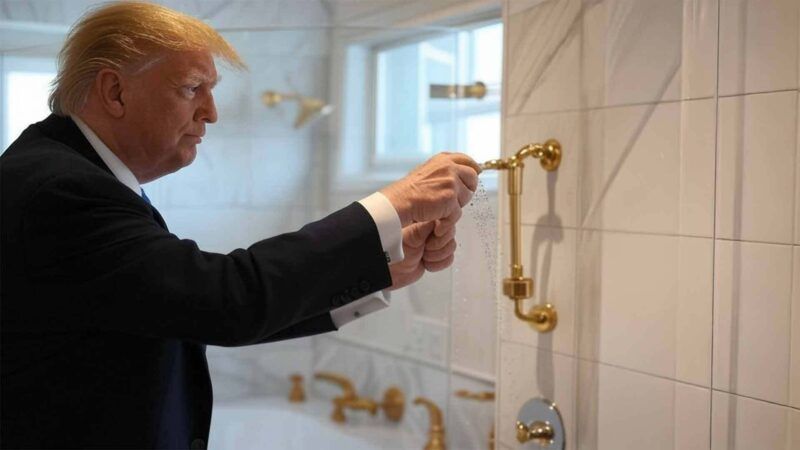Donald Trump Deregulates Showerheads…Again
From Obama, to Trump, to Biden, to Trump again, the definition of showerhead keeps changing.

On Wednesday evening, President Donald Trump issued an executive order that repeals the Biden administration's December 2021 definition of a showerhead—saying instead that the Oxford English Dictionary's definition of showerhead will do for the purposes of federal regulations.
"I like to take a nice shower to take care of my beautiful hair. I have to stand under the shower for 15 minutes till it gets wet," said Trump in the Oval Office Wednesday before signing the order.
The president's latest order is part of his longrunning pressure campaign against the appliance regulations of the Obama and Biden administrations. But the root of the issue goes back to the presidency of George H. W. Bush.
The 1992 amendments to the Energy Policy and Conservation Act (EPCA) require that showerheads emit a maximum of 2.5 gallons of water per minute.
To route around that limit, some manufacturers created multiheaded shower units. Each showerhead produced no more than 2.5 gallons of water per minute, but added together, they emitted far more water.
The Obama administration ended this regulatory arbitrage by issuing regulations establishing that the entire shower unit had to comply with the 1992 water flow limits.
Trump took a number of swipes at this rule during his 2016 campaign. In the waning days of his first term, he issued a new rule reversing the Obama administration's definition.
In December 2021, the Biden administration reversed course again and reapplied the Obama-era regulations saying that whole shower units, regardless of headcount, had to comply with the 2.5-gallon limit.
Trump has now reverted things back to his 2020 standards.
"Directionally, it's the right thing to do. Unfortunately, there's less to it than meets the eye," says Ben Lieberman, a senior fellow at the Competitive Enterprise Institute (CEI), which has long been critical of energy efficiency standards for household appliances.
Lieberman notes that no executive regulation can repeal the statutory requirement in the EPCA that showerheads emit just 2.5 gallons of water. Very few Americans have multiheaded showers that Trump has deregulated with his order, he says.
Trump's executive order also declares that his definitional change does not need to go through the standard notice-and-comment period typically required by the Administrative Procedure Act. That could make it more vulnerable to legal challenges.
In order to fully deregulate shower flows, Congress will need to act, says Lieberman.
In his Oval Office remarks, Trump did say he wanted Congress to "memorialize" his order and take on other energy regulations affecting toilets and faucets.
In addition to repealing more rules than the president can unilaterally, congressional deregulation of appliances would likely give manufacturers more confidence to actually invest in superior deregulated products.
The regulatory seesaw between Democratic and Republican administrations leaves companies unsure of whether deregulated, free-flowing shower units they produce one year will be banned again in the next.
Ironically enough, appliance manufacturers were at first critical of the Obama administration showerhead regulations (because they limited the products they could make) and the Trump administration's showerhead deregulations (because it'd require them to invest in creating newly legal products).
That latter industry critique of showerhead deregulation is obviously pure cronyism. Companies didn't want to have to spend money to compete with upstart multiheaded shower unit makers.
Enshrining showerhead deregulation in statute would get industry back on the side of free markets and allow free markets to deliver more choice to consumers.
Rent Free is a weekly newsletter from Christian Britschgi on urbanism and the fight for less regulation, more housing, more property rights, and more freedom in America's cities.




Show Comments (25)